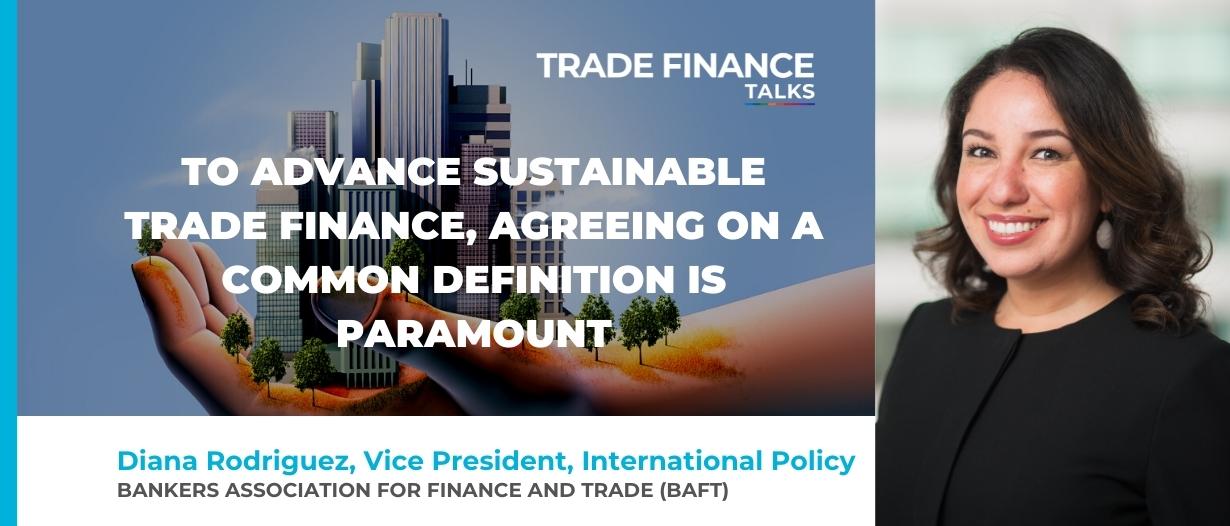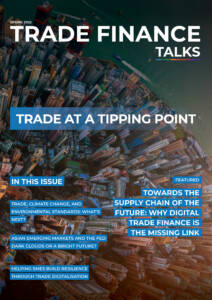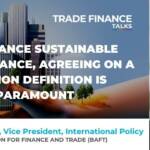Sustainability and ESG have become public and private sector priorities, with consumers and corporates alike increasingly focusing on sustainability practices when making financial decisions, and governments considering a wide variety of policy initiatives to drive behaviour.
As nations work to meet the UN Sustainable Development Goals (SDGs), there is an important role for the transaction banking industry to help achieve them.
Trade finance has a crucial role to play in supporting corporate efforts to position sustainability at the core of their business strategies, and throughout their supply chains.
For several years, banks have been offering ESG-linked products including green bonds and sustainable loans, and we see informal markets developing for the trading of carbon credits.
However, in order for sustainability-linked trade finance to gain traction and ubiquity, there is general agreement that market standard definitions, methodologies, and measurements are needed.
Competition for selling green bonds is heating up as BNP Paribas overtakes JPMorgan in first place https://t.co/afjKTJeTjv pic.twitter.com/cSWqKJjbHI
— Bloomberg (@business) February 10, 2022
Towards a common standards framework
The difficulty of defining workable sustainability standards for international trade should not be underestimated.
The volume of global trade transactions that cross multiple jurisdictions to form part of complex supply chains presents an inherent challenge to defining what constitutes sustainable trade finance – a market that accounts for more than a third of global trade.
Additionally, institutions are at different stages of their own journey toward sustainability, and have different priorities based on their geographic footprint and client base.
This complexity heightens the importance for the trade finance industry to coalesce around a common standard that reconciles the divergent banking landscapes and provides rigorous yet implementable standards.
Policymakers in certain regions are outlining public policy frameworks and taxonomies to support policy positions for companies operating within their jurisdictions.
In some cases, private enterprise is well ahead of the policy requirements, while in others they are being influenced by policy requirements.
An appropriate balance between the public and private sectors will shape policy in a way that incentivises behavior without creating unintended consequences with negative economic implications.
Industry advocates must strive to ensure that public policy reflects some consistency across jurisdictions, so as not to create undue advantages or burdens based on geography.
???? Interview: BAFT VP H. Scott Stevenson on #tradefinance, #COVID-19, #regulations, #ESG
— Trade Finance Global (@tradefinglobal) November 19, 2021
Stevenson will lead BAFT’s trade-focused policy, practices, and education initiatives, and support its trade-related councils and committees.
Full Interview ➡ https://t.co/0iAKqH9gds
BAFT’s role in sustainable transaction banking
In the past year, we have seen the market become more collaborative, with institutions working together through industry working groups and consortia to find innovative solutions to address sustainability in transaction banking.
Last year, BAFT launched a Sustainability Working Group to address the needs for standards, tools, education, and policy advocacy on behalf of the industry.
To address these challenges, the working group will be developing resources, training, and best practice standards to promote sustainability across the trade finance and global payments industry.
The working group is focusing its efforts on five work streams:
- Developing standards for sustainable transaction banking
- Principles on how to apply net zero to transaction banking
- Guidance on sustainability reporting
- Advocacy and education on sustainable transaction banking
- Defining an industry approach for the full spectrum of ESG – beyond the “E”
It is the objective of this working group to advance the interests of the transaction banking industry, while complementing and leveraging the work of other bodies.
To that end, the BAFT Working Group welcomed the ICC Standards for Sustainable Trade and Sustainable Trade Finance positioning paper published in November 2021.
The roadmap is a positive development and moves the industry closer to agreement on a common standard that the industry can reference.
BREAKING NEWS ????: A new ICC report has been published setting out proposals to tackle the challenge of defining and setting common standards for sustainable trade and trade finance.https://t.co/L9YYxHc9fl pic.twitter.com/JdaeRZ5EQ2
— ICC QATAR WBO (@ICC_Qatar) November 14, 2021
An equal-weighted ESG
As a common standard begins to take shape, much work remains to ensure broad industry support and wide adoption.
The first consideration is to ensure that equal weight is given to all elements of ESG.
While social and governance factors are generally taken into account for the calculation of an ESG rating, most of the taxonomies are still primarily focused on the “E” for environment.
The true impact of trade finance extends to the social and governance elements of ESG, and should be effectively represented in the emerging standard.
Second, recognising the transition needed to make business more sustainable, such standards must not only recognise positive activity, but also guide those involved towards what best practices, or even minimum acceptable standards.
While specific goods may not in themselves be sustainable, they can often be used for purposes that lead to sustainable ends.
Lastly, underpinning the development of any standard, care must be taken to be inclusive of the global nature of the business.
For a global sustainability standard to take hold, geographically diverse stakeholders must be an integral part of the development and adoption.
The sooner the industry can stand behind a shared understanding and common vocabulary of what is considered sustainable trade, the more effectively the industry can dispense with concerns over ESG-washing and realise the potential of sustainable trade finance.













































